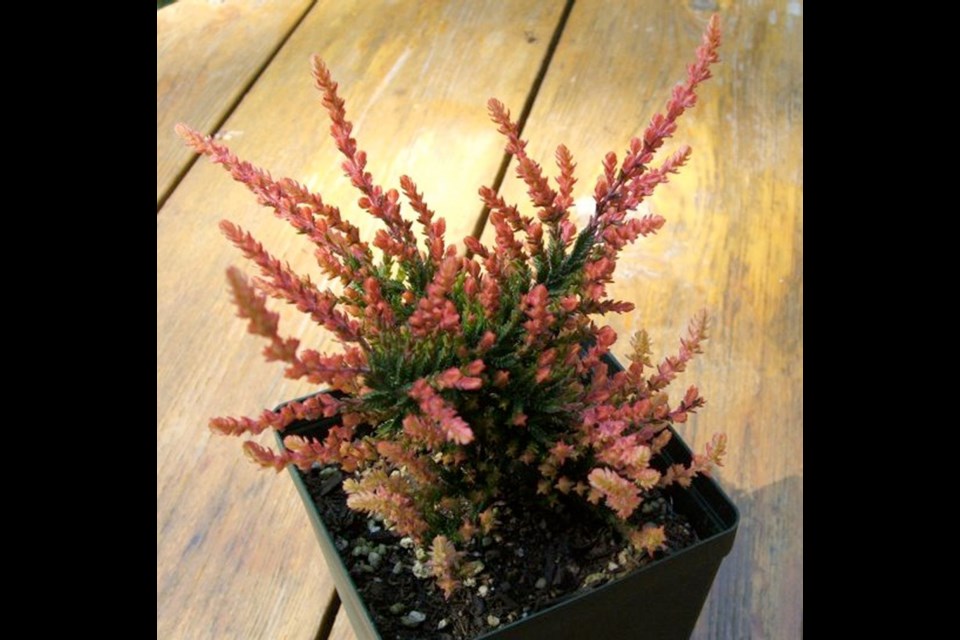Dear Helen: My partner and I planted a few new heathers and other small shrubs last month. The project involved some lively “discussion” over how to handle the roots of an unpotted plant before it is settled into a garden bed. When I see roots that are matted into a solid mass or running laps around the root ball, I want to untangle it all and clip back over-long roots before planting. My partner fears harm to the plant from manipulating the roots. What is your opinion on this issue?
T.H.
Whenever I’ve unpotted a purchased plant and found its roots bound into one tightly congested mass, I do my best to relieve that congestion before planting; otherwise, the plant rarely does well.
I use a root knife, but any sharp serrated knife would do, to slice thin sections off the bottom and sides of the root ball. Then I try to tease out some individual roots before planting.
Tightly root-bound heathers in one-gallon nursery pots have done badly in my garden. For that reason I look around for young plants, purchased in smaller pots around 10 cm wide. These smaller plants usually have not had time to form a solid mat of roots. They always settle in rapidly and become satisfying long-term plants.
When roots are running circles around the root mass, I gently unwind them and clip them off even with the root ball. I also carefully pull free any other roots that are glued to the root ball. This loosens roots from entrapment and allows them to grow freely into the surrounding soil of their new home.
Dear Helen: Do you know of any potato varieties that produce well in less than ideal conditions? I relish home-grown potatoes, but my plantings never yield much.
S.L.
Try Kennebec, a variety that’s been around since 1941. It’s a reliably high-yielding potato that will tolerate a broad range of growing conditions. The tubers are medium to large, oblong in shape, with a thin, light tan skin and white flesh.
Kennebec is a good all-purpose potato that holds together well when cooked and is fine for mashing, roasting, making chips or for potato salads. It’s a mid to late season potato.
Just recently I was commiserating with a gardener who, like me, must deal with invasive cedar roots in parts of the food garden. In a follow-up note from her, she added this: “Would you believe that, amidst a tangle of cedar roots, I actually dug up 40 lbs of heroic Kennebec potatoes.”
Another potato that has done surprisingly well in parts of my food garden is a “gourmet” potato called AmaRosa. This is a small, elongated potato with reddish skin and bright pinkish-red flesh that is delicious. I usually halve the long tubers lengthwise and roast them sprinkled with grapeseed oil and a freshly grated sea salt and kelp blend from Gathering Place on Cortes Island (gatheringplacetrading.com).
Both Kennebec and AmaRosa are available at some garden centres in the spring. Roasted AmaRosa, and Kennebec steamed tender and mashed with butter and cream, are supreme among comfort foods from the garden.
Dear Helen: Late in the summer I discovered that a rat was eating the ripe tomatoes at the lower parts of my potted plants. What precautions can I take to keep this from happening next year?
L.P.
Two measures come to mind. One is to arrange a fine mesh wire cage around each pot and plant. Secure the wire tightly to the pot and drape sections of tightly woven netting over top. Or, set stakes in the soil at the pot edge and secure netting around and over the plant. Set up any enclosure for easy opening and access for watering, pruning and harvesting.
Another possibility is to set a trap or traps by the containers. When a friend of mind had rats eating the produce in her greenhouse, she inquired at a local farm supply store and came away with a battery powered electronic trap that dealt with the rats quickly and cleanly.
GARDEN EVENTS
Nanaimo meeting. The Nanaimo Horticultural Society will meet this evening at 7 in First Unitarian Fellowship Hall, 595 Townsite Rd. Jo Canning will discuss composting and there will be a judged parlour show. More information at 250-758-6783.
Floral art. The Mid Island Floral Art Club will meet on Thursday at 2 p.m. in St. Stephen’s Church Hall, 150 Village Way in Qualicum Beach. Theme for the afternoon: All Inclusive Design. Information at 250-752-1858.



